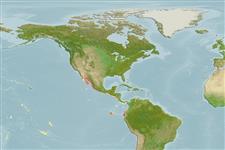Actinopterygii (ray-finned fishes) >
Perciformes (Perch-likes) >
Opistognathidae (Jawfishes)
Etymology: Lonchopisthus: Greek, logche = lance + Greek, opisthe = behind (Ref. 45335).
Environment / Climate / Range
Ecology
Marine; demersal; depth range 10 - 40 m (Ref. 55763). Tropical, preferred ?
Eastern Central Pacific: Gulf of California.
Size / Weight / Age
Maturity: Lm ? range ? - ? cm
Max length : 30.0 cm TL male/unsexed; (Ref. 11482); common length : 20.0 cm TL male/unsexed; (Ref. 55763)
Short description
Morphology | Morphometrics
Dorsal
spines
(total): 11;
Dorsal
soft rays
(total): 17-19;
Anal
spines: 3;
Anal
soft rays: 17 - 18. Body somewhat elongated, narrowing posteriorly; head and mouth large; caudal fin lanceolate and much longer than total length of head; head and body cinnamon or cream with diffuse bluish spots. Operculum with an intense blue spot; median fins violet (Ref. 55763).
Most specimens taken from flat sandy bottoms. Feeds on benthic and planktonic invertebrates.
Life cycle and mating behavior
Maturity | Reproduction | Spawning | Eggs | Fecundity | Larvae
Allen, G.R. and D.R. Robertson, 1994. Fishes of the tropical eastern Pacific. University of Hawaii Press, Honolulu. 332 p. (Ref. 11482)
IUCN Red List Status (Ref. 115185)
CITES (Ref. 94142)
Not Evaluated
Threat to humans
Harmless
Human uses
More information
Common namesSynonymsMetabolismPredatorsEcotoxicologyReproductionMaturitySpawningFecundityEggsEgg development
Age/SizeGrowthLength-weightLength-lengthLength-frequenciesMorphometricsMorphologyLarvaeLarval dynamicsRecruitmentAbundance
ReferencesAquacultureAquaculture profileStrainsGeneticsAllele frequenciesHeritabilityDiseasesProcessingMass conversion
Tools
Special reports
Download XML
Internet sources
